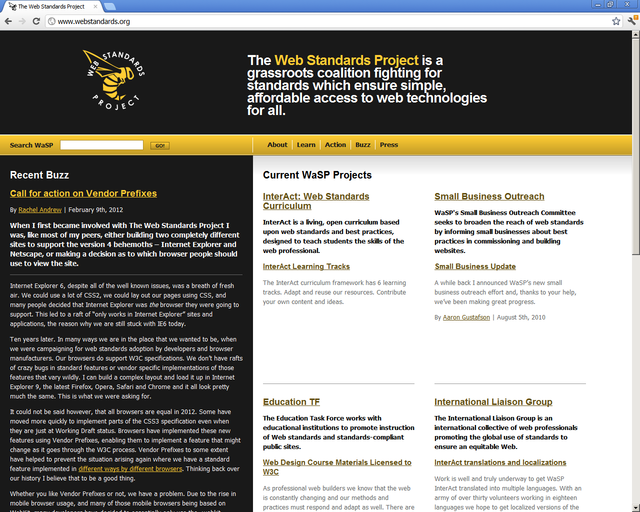Content
- Why standards are important?
- Are there any standards in web development?
- The Web Standards Project
- Sources of information
- Erroneous examples
According to Wikipedia, standardization is...
...the process of developing and implementing technical standards.
The goals of standardization can be to help with independence of single suppliers (commoditization), compatibility, interoperability, safety, repeatability, or quality.
Are there any standards in web development? Some of the current web technologies:
- Client:
- HTML
- DHTML
- CSS
- JavaScript
- VBScript
- ActiveX
- Applets
- Flash
- ...
- Server:
- CGI
- SSI
- IDC
- ASP
- ASP.net
- PHP
- JSP
- Servlets
- ColdFusion
- CSP
- ...
The Web Standards Project (WaSP) fights for standards that reduce the cost and complexity of development while increasing the accessibility and long-term viability of any site published on the Web. WaSP works with browser companies, authoring tool makers, and web developers to deliver the true power of standards to the Web.
What standards? When WaSP speaks about core or key standards for the Web, they mean:
- Structural and Semantic Languages
- Hypertext Markup Language (HTML) 4.01
- Extensible Hypertext Markup Language (XHTML) 1.0
- Extensible Markup Language (XML) 1.0
- Presentation Languages
- Cascading Style Sheets (CSS) level 1
- CSS level 2 revision 1
- CSS level 3 (CRs or better)
- Object Models
- Document Object Model (DOM) level 1
- DOM Level 2 (HTML, Core, Events, Traversal)
- DOM Level 3 (Core)
- Scripting Languages
- ECMAScript 262 (the standard version of JavaScript)
- Advanced browsers which have fully implemented the above should consider implementing the following:
- Extensions and updates to HTML4 and XHTML 1.0
- microformats
- Web Applications 1.0 (AKA "HTML5")
- XHTML 1.1
- Additional Markup Languages
- Mathematical Markup Language (MathML) 1.01
- MathML 2.0
- Extensions and updates to HTML4 and XHTML 1.0
The World Wide Web Consortium (W3C), along with other groups and standards bodies, has established technologies for creating and interpreting web-based content. These technologies, which are called web standards, are carefully designed to deliver the greatest benefits to the greatest number of web users while ensuring the long-term viability of any document published on the Web.


